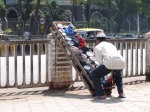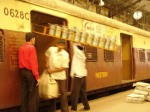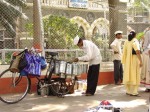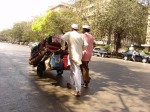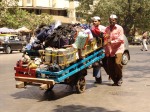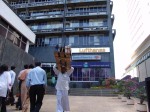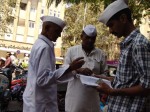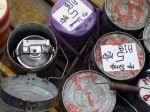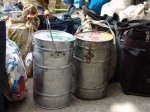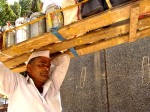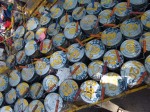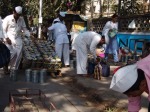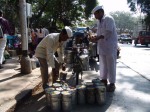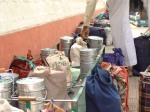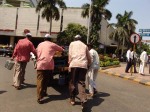(Vinay Venkatraman with Stefano Mirti, first published on “Domus”, n, 885, December 2005)
……………………………………………………………………………………………………………………………………………………………..
India is famous for its service-oriented culture. From the past to the contemporary dynamism, there are plenty of well-know services in every field of human activity. From the call-centers to some of the finest educational institutions of the whole Asian continent (the National Institute of Design in Ahmedabad for all), Bollywood and the high-tech sector with its impressive software and hardware research centers.
The Indian subcontinent is now rivaling China and it starts to get a lot of attention from abroad. Attention to its products, but also to its services. In the same way we can have top-class or “anonymous” design, a lot of interesting things can be found in terms of services. In this article we will talk about one of the most impressive services you can find around (although not really know to the foreigners): the Mumbai “DabbaWalla”.
We can start from the name. In hindi language, “Dabba” means box, and in this case it is referred to the lunchbox. While “Walla” is a suffix: the person. “DabbaWalla” altogether then means: the person who carries the lunch-boxes.
As the name says, it is a service. The lunch-boxes are carried from the home in the suburbs (where the food is cooked) to the people working downtown, in the big city. Let’s say that it is about people carrying lunch-boxes. In order to understand what make it so special, we have to talk a little about the cultural background.
The typical Indian cooking style is based on a number of time consuming activities at time rather tedious. If we talk about the middle class, we have a system where the husband goes out for work early in the morning, while his wife is home taking care of all the household activities. The problem is that the wife can’t finish the daily cooking before her husband leave. Given the length of the cooking process, she generally finishes by late-morning, let’s say around 11.
Of course, there are many options to get lunch at your workplace. It can range from the street-vendors to all kind of restaurants. Still, most people prefer to eat food from home. Culturally the food must be from home because of quality, taste and nutritional factors. There is idea that the food bought on the street cannot be eaten on regular basis. If the food comes from home, the quality is of course higher and the taste is perfectly fitting the personal preferences. No one knows your taste better than your wife.
All of these cultural elements generate this quite impressive phenomenon called “DabbaWalla”. Having to give a definition, we could go for something like: “an highly efficient human based logistical system for food supply”. Bluntly, hundred thousand lunch boxes are delivered on a daily base from the house-holds to the different work-places. And, of course, back. Every day, hundred thousand women cook food, and their food is delivered to their men working somewhere else in the city.
Once arrived here, the reader could ask a very simple question. If you must eat home cooked food, and the cooking is lengthy and tedious, why don’t they cook the food the night before? The European blue-collars used this system for more than a century. To answer this, another element has to be taken into account. Mumbay is a city where to commute is hectic, is chaotic. To carry the food along, would be extremely cumbersome. This is why the “DabbaWalla” comes helpful.
Basically you subscribe to the service, on a monthly base. You pay about 200 rupees per month. 4 Euro, in a world where the average salary would be about 10.000 rupees (200 Euro). Every day, the “DabbaWalla” men come and they pick up the lunch box from home. The food is then delivered to the working man wherever he is. Although the process of delivery is complex (involving quite impressive distances), the boxes never get lost. The system is completely standardized and the process runs very smoothly.
First of all, the lunch-box where the food is contained is placed in a bigger one. The bigger one is provided by the “DabbaWalla” has a standard form and it is clearly marked. The home food in its original container is placed in another standard modular box in order to facilitate the transportation.
As you can see from the images, each box has a big code painted on it. For instance, the code refers to the final destination. The informational system is color based. Every color carries a different meaning in terms of areas of city. Then, you have the codes, made out of letters and numbers. They refers to the final destinations (buildings, floors), as well as to the waypoints along the way (the station where they have to be delivered first, the station where they have to get off the train and so on. Also, there is always a part of the code referring to the carrier.
The wife cooks, the food is placed in its box, then the box, like in the Matrioska system gets placed into a bigger standardized one. The “DabbaWalla” comes, and picks the box. From there on, the operation is based on the local railway system and foot-messengers. The same “DabbaWalla” who came to your home goes to station where the boxes are sorted and clustered. At the station there is the first “hand-exchange”: there is a second person organizing them and carrying them into the train. The person on the train knows which boxes have to be drop at each station on the line.
The boxes are then handed over to another “relay” of the system. One per station. Now, our box has been moved from the original house to the train station. Traveled by train till its station where it gets taken by another person. The stations downtown have a new sorting system where the boxes get together upon their final destination. Now, the “terminal” DabbaWalla is ready to carry the box to the specific office where the hungry person is waiting for it.
All of this is quite impressive. Even more if you think that the average box moves about 40 kilometers per day. One way. This trip, in less than one hours.
In terms of quantity, although difficult to count, there are some estimate on how many boxes are carried around. A rough esteem would count about 200.000 boxes per day, involving about 4.500 carriers. In terms of economics, we could esteem an annual turnover of about 50 million Rupees (almost one million Euro). Also, the “DabbaWalla” are well-know for never losing any box.
The origin of the system can be traced all the way to one hundred years ago. By then, it was a small thing. It kept growing until the peak in the mid 70’s. In that period there has been the textile mill boom in Mumbay. All sudden you had hundred thousand people commuting every day, as we mentioned before, there was the lunch issue… Since then the population (as well as the economy) kept growing and this how we get to the present situation.
Also interesting is to note that this is really a Mumbay thing, not happening in other Indian metropolis. This is because of the long distances of commuting, the good local railway system and because of the specific “entrepreneur-oriented” attitude of the locals. Even in lower classes, people like very much to work in this kind of service oriented business.
We all know that India is a place where the service-oriented activities are well developed and refined. These descriptions refer to specific Indian features in the same way the Toyota “Just-in-time” system is linked to Japan. In the West, we could refer to a various number of supply chain management principles.
To us, “DabbaWalla” is interesting because, although the most important in terms of scale and efficiency, there are similar things in different fields.
Of course, “DabbaWalla” is special because it is amazingly efficient. Our photographer had problems running after them while taking pictures… Although carrying the loads, still the carriers were incredibly fast and to take picture not losing them has been a real difficulty.
Anyway, in any big Indian city, there are similar services referred to grocery deliveries, and other consumer oriented businesses.
In the past, (as well as in the present) big supermarket chains tried to enter the market, but the way the business is run by the local groceries makes it very difficult. I am home, I call the little shop, they carry whatever I want/need, very quickly and even if they don’t have what I want, they will find it (and deliver) for me.
There are even peculiar micro-businesses like the “shoe-laundry”. You call, they come to your house pick up your shoes and return them perfectly clean and polished. Or, think to the “Kabadiwalla”: the junkman. You call him (nowadays even the junkman own a cellphone), he comes to your home picking up paper, glass, metal… He always carries a scale, weights the different materials collected and pay you upon the weight.
Using the contemporary definition, these are all services to the consumers. Apart from these, there are also meaningful examples in the so called “business to business”. Although not completely legal, there are a lot of “banking-like” systems. If you want to transfer quickly money (especially cash), there are much faster ways then to go to a bank. You deposit cash in one point, you get a password, and the withdrawer to the other side goes to a specific place where, giving the password, he gets cash right away. Not even electronic banking can be so fast. Again, all these systems are based on complete trust. You can have this trust because all the people in the process do belong to the same community. The name for this service is “Angadias” and it comes out of the diamond trades and business.
Finally, after talking a lot about the service itself and similar ones, it is important to complete our description talking about the people running the service.
The majority of them belong to specific communities originated in little villages in Mumbay area. Also, it is important to notice that the system is not “vertical”. Operationally the system is horizontal. At the same time there is not “the boss” or the central office running the operation. The sense of responsibility comes because of the community spirit. This is probably one of the most distinct features of this system. We must also say that an important role is played by the association covering the various activities of the different carriers. The association is the place where the different issues are discussed, problems addressed via a system of regular meetings.
The service is run upon an highly “communitarian” structure. Common protocols, strict discipline and a shared agenda with common goals. Other distinct features worth to mention are the ones referred to the general micro-economy of it.
From the financial point of view, it is obvious that the “DabbaWalla” doesn’t need high investment or capital. The different carriers use bicycles, carts, public trains and a lot of foot-work. Still, there is a quite refined business model. The association is able to guarantee a number of sophisticated things like access to credit (if needed) as well as “social welfare” like guarantees (if you get ill, if you get an accident…). The price of the service comes out from a well-thought strategy: it is purposetly kept low, because the overall business is made out of the sheer volumes.
There important thing to mention is related to the social status. In the Indian culture, people like “DabbaWallas” are considered as “annadattas” (literally: the person who provides food). Upon tradition they are well respected and considered as a very trustworthy citizens.
—
(pictures taken by Priya Mani)

